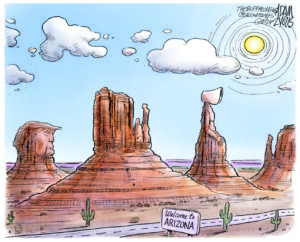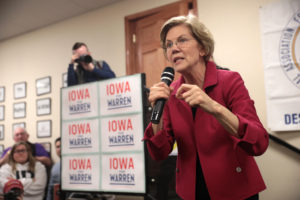Arizona Teachers Push Proposal to Tax Rich for Education
The growing teachers movement aims to qualify and pass a ballot initiative that would funnel nearly $690 million annually to education.PHOENIX — On a sweltering Arizona evening under a park pavilion, math teacher Heather LaBelle handed out petitions for a ballot initiative that would increase taxes on wealthy residents to get funding for schools. Later that night, her school board voted to give her and her fellow teachers an average raise of 15.5 percent.
LaBelle, like many in Arizona’s #RedforEd movement that triggered a six-day teacher walkout, says improving teacher pay is just one step toward better schools.
“The longer we wait, the longer we have a generation and two generations of kids that don’t have the tools they need,” she said.
Arizona was a key state in a spring that saw teachers around the U.S. mobilize to demand better education funding. They wound up netting hundreds of millions of new dollars in the state budget — much of it going to teacher pay raises — after their historic walkout shuttered most of Arizona’s schools.
Districts around the state have since spent the end of the school year authorizing the first rollout of their pay raise plans — even as the growing teachers movement turned its attention to qualifying and passing a ballot initiative that would funnel nearly $690 million annually to education.
The new state budget authorizes a 20 percent teacher pay raise over the next three years. When fully implemented, the plan will cost $645 million, according to a state budget analysis. There’s also a partial restoration of nearly $400 million in recession-era cuts, with a pledge to fill in the rest within five years.
But some say the funds aren’t nearly enough to reverse Arizona’s teacher vacancy crisis and address longstanding concerns like crumbling infrastructure, large class sizes and lagging math and reading scores.
“School districts still have needs way beyond what this plan pays for,” said Chris Kotterman, director of governmental relations with the Arizona School Boards Association.
For LaBelle and others, that’s where the ballot initiative comes in. The Invest in Education Act would increase income taxes for those who earn more than $250,000 a year. Sixty percent of the money raised would go toward teacher pay, with the rest earmarked for maintenance and operations.
Supporters must collect more than 150,000 valid signatures by July 5 to get the initiative on the November ballot.
Joe Thomas, president of the Arizona Education Association that co-helmed the walkout, is bullish about its prospects. People are willing to tax themselves to give students a quality education, he said.
An April poll from The Associated Press-NORC Center for Public Affairs Research found half of Americans would pay higher taxes to pay teachers more and provide money to schools, with 26 percent opposed. The results cut differently on a partisan basis: 69 percent of Democrats said yes to higher taxes for schools compared with 38 percent of Republicans and 30 percent of independents who say the same.
Opponents of the Invest in Education Act, including the Arizona Chamber of Commerce, maintain it would harm small-business owners and the state’s economy.
Republican Gov. Doug Ducey says he won’t comment on ballot initiatives until they qualify, but he’s been vocally opposed to tax increases.
The governor feels the state can afford the raise plan because of better-than-expected revenue projections, spokesman Daniel Scarpinato said.
Scarpinato also said solving a teacher shortage takes multiple steps. He pointed to a new initiative that gives free tuition to teachers who study at Arizona’s three major public universities and agree to stay in the state for four years.
As of December, nearly 2,000 Arizona teacher positions remained vacant. Another 4,303 were filled by individuals who don’t meet standard requirements, according to the Arizona School Personnel Administrators Association. Combined, that represents two-thirds of total teacher openings.
Metro Phoenix’s Washington Elementary School District — one of Arizona’s 10 largest — struggles to get applicants because of low pay, said Justin Wing, its human resources director and a past association president. It authorized an average of a 6.5 percent teacher raise before the walkout. Doing so was a heavy lift that involved reassigning staff to save money, Wing said.
The new state budget allows the district to distribute an average of 15.5 percent raises for teachers and an average of 10.6 percent raises for hourly staff next year. But Wing says even with the increases, it will be difficult for Arizona to attract teaching candidates.
“If there was no commitment from the state, we’d be in a world of hurt in education,” he said.
In Mesa Public Schools, the state’s largest district, a 10 percent teacher raise will put new-hire base salary at $41,850, up from $38,500. Employees who are paid by the hour will get a 5 percent raise or a fixed 50-cent to 80-cent hourly bump, based on which is greater. Other Phoenix-area increases going to teachers include:
— 10 percent raises at Chandler Unified School District and the Dysart Unified School District with 5 percent pay raises for support staff.
— 11.34 percent raises for certified classroom teachers in the Peoria Unified School District, plus raises for non-classroom teachers, staff and administrators.
— 12 percent raises for teachers at the Paradise Valley School District, including three percent that was approved April 19, plus raises for support staff and administrators.
Christine Thompson is CEO of Expect More Arizona, a group that aims to improve education opportunities and quality. She said this year’s state budget marks progress, but the changes made now could take years to shake out. A middle schooler who has never had a permanent math teacher, for example, may be affected by that for the rest of their educational career.
“We’ve got a very long way to go,” Thompson said. “So, appreciate the steps, stay at the table as part of the conversation, and recognize that all of these things help us in the direction of where we need to go.”
Your support matters…Independent journalism is under threat and overshadowed by heavily funded mainstream media.
You can help level the playing field. Become a member.
Your tax-deductible contribution keeps us digging beneath the headlines to give you thought-provoking, investigative reporting and analysis that unearths what's really happening- without compromise.
Give today to support our courageous, independent journalists.









You need to be a supporter to comment.
There are currently no responses to this article.
Be the first to respond.